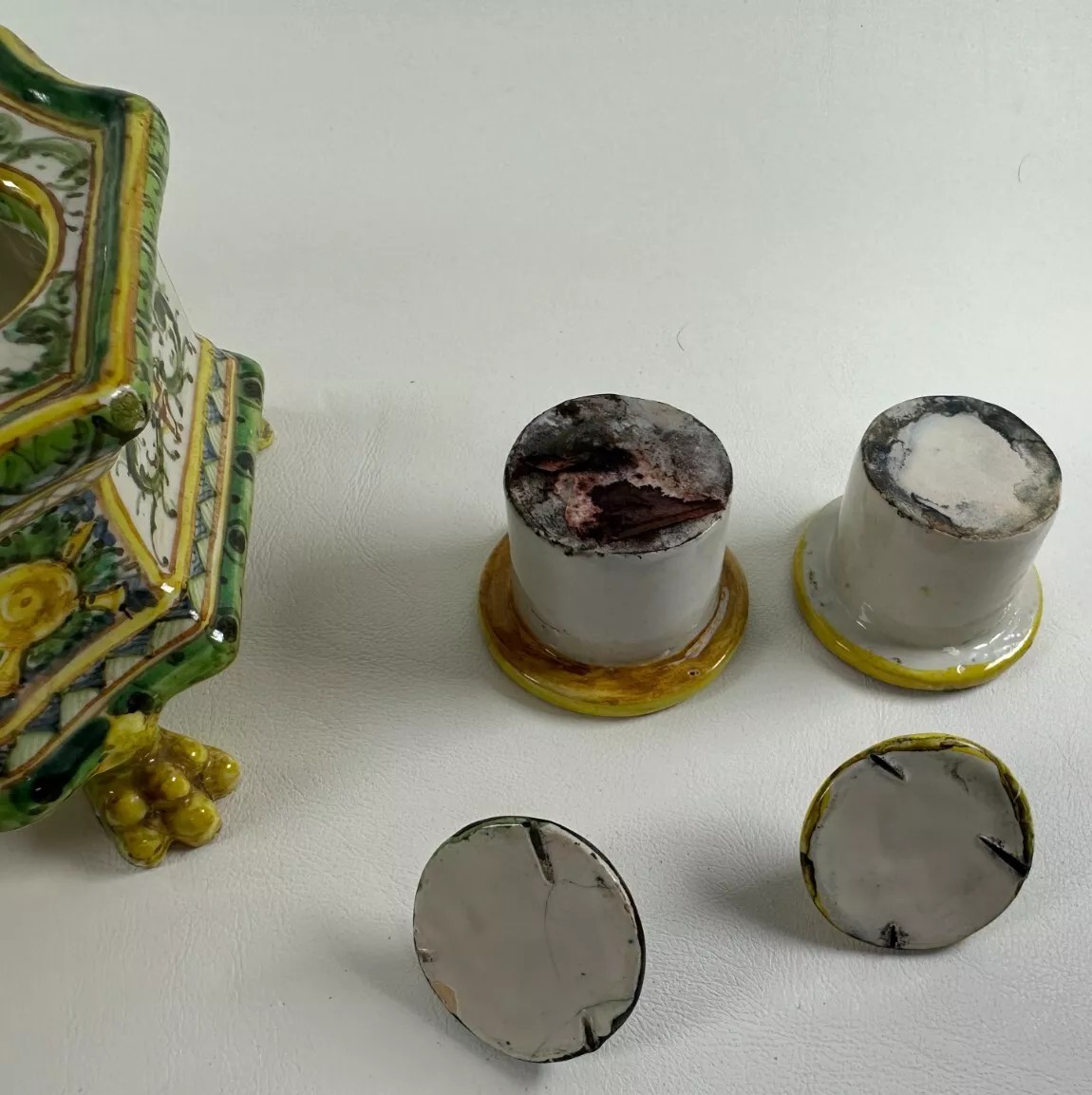
Inkipedia
Italian Majolica Inkstand
| Categories | Ceramics/Porcelain non-Figural |
| Material | Majolica |
| Markings | See Narrative |
| Manufacturer | Undetermined |
| Origin | Italy |
| Date or Era | circa 1900 |
| Measuring | 7 ¾” x 4 ¾” x 7” high |
Description of the Inkstand:
- Overall Form and Base: The inkstand features a broad, oblong base that stands on four lion’s paw feet. These feet, along with the overall form, suggest a classical or Renaissance influence, aiming for a grand and substantial desktop presence.
- Inkwells: The inkstand holds two distinct ink pots, one on each side of the central urn. These inkwells have lift-off (unattached) lids.
- Central Urn: A central urn is affixed to the base between the two ink pots. It may have held a small candle (taperstick) for melting sealing wax, it may have held pens, or it may just be decorative.
- Indentations: On one side of the base, there is a distinct depression or “trough” specifically designed to store a pen horizontally. On another part of the base, there is a smaller, molded indentation featuring a woman’s face. This face is likely a classical or allegorical representation, typical of Renaissance and Neoclassical art.
- Decoration:
- Dominant Floral Motifs: The florals are stylized and exuberant, consistent with Renaissance and later revival Majolica styles.
- Scrolling foliage and intertwining vines are prevalent, connecting the floral clusters and filling the available space on the inkwell’s surface and the base.
- Color Palette: The colors are rich and bold, characteristic of Majolica, with greens and yellows prominent.
- Border Elements: Along the edges and transitions of the inkstand, there are decorative borders that complement the central floral themes. These include geometric patterns, stylized leaves, and small scrollwork, providing a framework for the main designs.
- Majolica (or Maiolica in Italian): This refers to tin-glazed earthenware, primarily produced in Italy from the Renaissance onwards. It’s characterized by:
- Earthenware Body: A relatively coarse, opaque, and porous clay body, fired at a lower temperature.
- Tin Glaze: After a first firing, the piece is coated with an opaque white glaze containing tin oxide. This white surface acts like a canvas.
- Overglaze Painting: Designs are then painted directly onto this unfired tin glaze using metal oxide pigments.
- Second Firing: The piece is then fired a second time at a relatively low temperature, which melts the glaze, making it smooth and glossy, and setting the colors. This process often results in the characteristic vibrant, often slightly blurred appearance of Majolica colors.
Maker’s Mark:
- The underside mark: “M” (likely a maker’s initial or symbol), “ITALIA,” and “BOLOGNA”.
Sold for $275 in June 2025
Content disclaimer. The information posted is the owner’s best knowledge and may not have been vetted by the SOIC. We welcome comments, corrections, and additions, working to make our website information comprehensive and accurate.
Join the Society of Inkwell Collectors (SOIC) – it’s free!
Founded in 1981 as a non-profit organization,
we are documenting inkwells (and accessories).
We’re here to help and inform!












